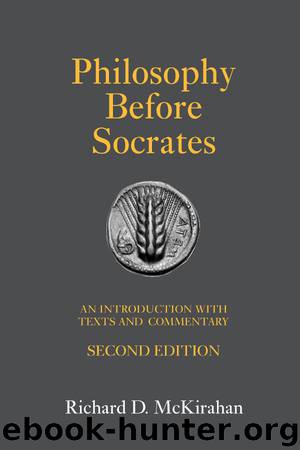Philosophy Before Socrates by McKirahan Richard D

Author:McKirahan, Richard D. [Richard D. McKirahan]
Language: eng
Format: epub, pdf
Tags: Philosphy
ISBN: 978-1-60384-561-8
Publisher: Hackett Publishing Company, Inc.
Published: 2010-03-14T16:00:00+00:00
Physical Principles
14.58, which appeared relatively early in Empedocles’ treatise,47 introduces the chief characters and processes of the kosmos: four elements (fire, air, water, earth) and two sources of change (Love and Strife), which cause the reciprocal processes of unification and separation. The last section (beginning at line 36), added from the Strasbourg papyrus with its use of the pronoun “we” in lines 36 and 56) also speaks of “our” role in the pageant of cosmic history in a way that makes it clear that it is no longer possible to suppose that Empedocles’ statements about “us” and our mournful condition have nothing to do with his physical theory.48
At the elemental level there are four basic substances (line 18). These are eternal (line 35) and fixed in quantity (lines 27, 32–33). They do not change into one another (line 35) or come to be or suffer destruction or undergo change in their basic qualities (lines 31–34). They maintain their identity intact (line 35). Each exists fully, and aside from them (and Love and Strife) there is nothing (line 30). Empedocles calls them not “elements,” but “roots” (an evocative term which suggests that they are living sources from which other things grow) to which he gives the names of gods in 14.46. The Sicilian goddess Nestis (used as another name for Persephone, goddess of the underworld) represents water, Zeus is fire, and Hera and Aidoneus (another name for Hades) probably represent air and earth, respectively.49 Empedocles uses a range of terms for his elements. Fire is also flame, sun (Helios), “the shining one” (Elektor), and Hephaestus. Water is also called rain and two names (Pontos and Thalassa) which both translate as “sea.” Air is Heaven (Ouranos) and aithēr. Earth is referred to in several ways (Chthon, Gaia, Aia) which all translate as “earth.”
The variation in names raises an important question—did Empedocles conceive of his elements as pure substances? Since he knew that rain is fresh water and sea is salt water,50 he should recognize that seawater is impure in comparison with rainwater. This way of thinking leads to the concept of perfectly pure water, air, etc.—idealized forms of these materials which perhaps never occur in isolation in the kosmos around us but out of which substances we encounter (such as rainwater and seawater) are composed. But the use of “sea” and “rain” indifferently as names for the same element may point to the opposite view, that seawater and rainwater (perhaps other liquids too) are each fully as much water as any of the others, so that the term “water” covers many liquids, and likewise “air” many gases, and “earth” many solids. Alternatively, if Empedocles held that the elements are, properly speaking, “pure,” the variety of names by which he calls them may be a deliberate maneuver to avoid identifying any single familiar substance with a pure element. 14.46, then, may be more than allegory, since ordinary conceptions of the gods are misguided (14.80; with lines 4–5, compare 14.145 line 10): the names “Zeus,” “Hera,” etc.
Download
Philosophy Before Socrates by McKirahan Richard D.pdf
This site does not store any files on its server. We only index and link to content provided by other sites. Please contact the content providers to delete copyright contents if any and email us, we'll remove relevant links or contents immediately.
The remains of the day by Kazuo Ishiguro(8361)
Tools of Titans by Timothy Ferriss(7771)
Giovanni's Room by James Baldwin(6782)
The Black Swan by Nassim Nicholas Taleb(6744)
Inner Engineering: A Yogi's Guide to Joy by Sadhguru(6424)
The Way of Zen by Alan W. Watts(6273)
Asking the Right Questions: A Guide to Critical Thinking by M. Neil Browne & Stuart M. Keeley(5339)
The Power of Now: A Guide to Spiritual Enlightenment by Eckhart Tolle(5315)
The Six Wives Of Henry VIII (WOMEN IN HISTORY) by Fraser Antonia(5216)
Astrophysics for People in a Hurry by Neil DeGrasse Tyson(4991)
12 Rules for Life by Jordan B. Peterson(4156)
Housekeeping by Marilynne Robinson(4044)
The Ethical Slut by Janet W. Hardy(4022)
Skin in the Game by Nassim Nicholas Taleb(3957)
Double Down (Diary of a Wimpy Kid Book 11) by Jeff Kinney(3904)
Ikigai by Héctor García & Francesc Miralles(3855)
The Art of Happiness by The Dalai Lama(3835)
Skin in the Game: Hidden Asymmetries in Daily Life by Nassim Nicholas Taleb(3714)
Walking by Henry David Thoreau(3672)
